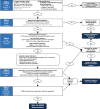Parameters associated with successful weaning of veno-arterial extracorporeal membrane oxygenation: a systematic review
- PMID: 36471408
- PMCID: PMC9724323
- DOI: 10.1186/s13054-022-04249-w
Parameters associated with successful weaning of veno-arterial extracorporeal membrane oxygenation: a systematic review
Abstract
Purpose: Veno-arterial (VA) extracorporeal membrane oxygenation (ECMO) can be used to restore organ perfusion in patients with cardiogenic shock until native heart recovery occurs. It may be challenging, however, to determine when patients can be weaned successfully from ECMO-surviving without requiring further mechanical support or heart transplant. We aimed to systematically review the medical literature to determine the biomarkers, hemodynamic and echocardiographic parameters associated with successful weaning of VA-ECMO in adults with cardiogenic shock and to present an evidence-based weaning algorithm incorporating key findings.
Method: We systematically searched PubMed, Embase, ProQuest, Google Scholars, Web of Science and the Grey literature for pertinent original research reports. We excluded studies limited to extracorporeal cardiopulmonary resuscitation (ECPR) as the neurological prognosis may significantly alter the decision-making process surrounding the device removal in this patient population. Studies with a mixed population of VA-ECMO for cardiogenic shock or cardiac arrest were included. We excluded studies limited to patients in which ECMO was only used as a bridge to VAD or heart transplant, as such patients are, by definition, never "successfully weaned." We used the Risk of Bias Assessment tool for Non-Randomized Studies. The study was registered on the International prospective register of systematic reviews (PROSPERO CRD42020178641).
Results: We screened 14,578 records and included 47 that met our pre-specified criteria. Signs of lower initial severity of shock and myocardial injury, early recovery of systemic perfusion, left and right ventricular recovery, hemodynamic and echocardiographic stability during flow reduction trial and/or pump-controlled retrograde trial off predicted successful weaning. The most widely used parameter was the left ventricular outflow tract velocity time integral, an indicator of stroke volume. Most studies had a moderate or high risk of bias. Heterogeneity in methods, timing, and conditions of measurements precluded any meta-analysis.
Conclusions: In adult patients on VA-ECMO for cardiogenic shock, multiple biomarkers, hemodynamic and echocardiographic parameters may be used to track resolution of systemic hypoperfusion and myocardial recovery in order to identify patients that can be successfully weaned.
Keywords: Adults; Biomarkers; Cardiogenic shock; Echocardiography; Extracorporeal life support; Extracorporeal membrane oxygenation; Hemodynamic parameters; Left ventricular function; Right ventricular function; VA-ECMO.
© 2022. The Author(s).
Conflict of interest statement
On behalf of all authors, the corresponding authors state that there are no competing interests.
Figures



References
Publication types
MeSH terms
LinkOut - more resources
Full Text Sources
Medical
Miscellaneous

